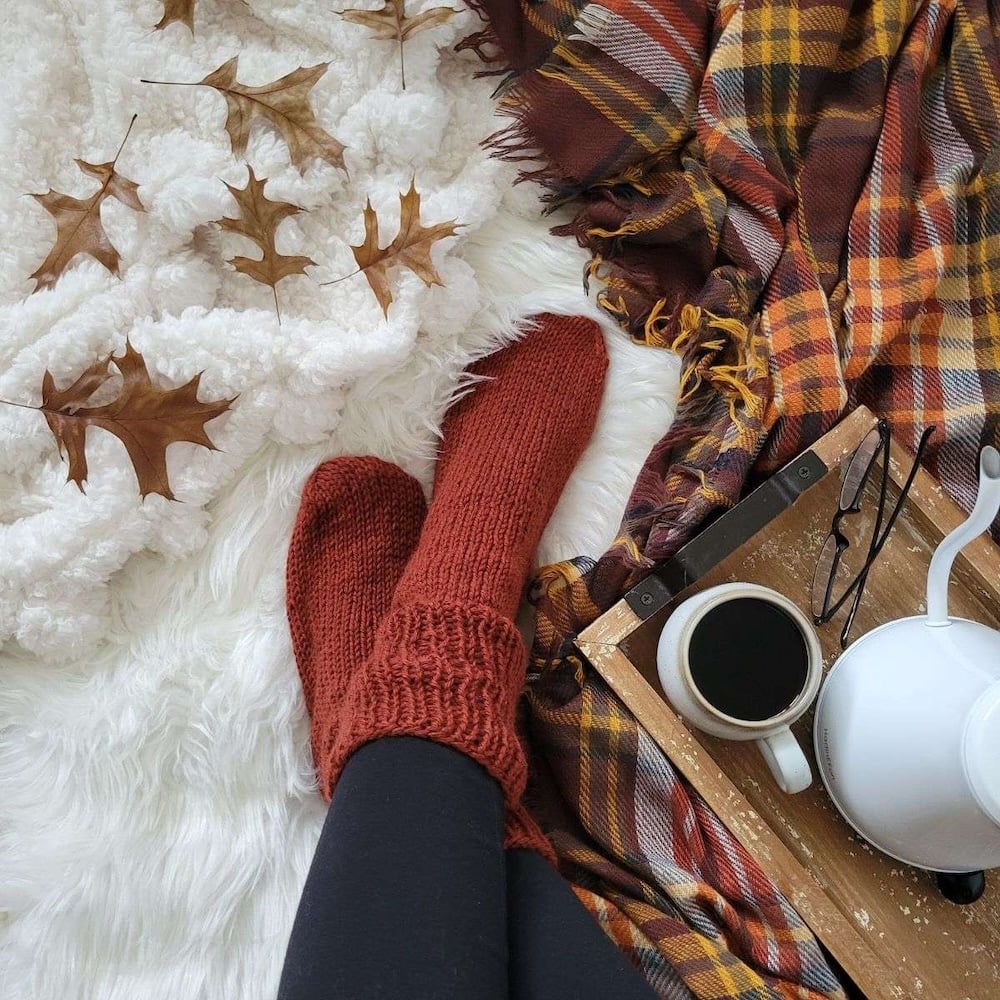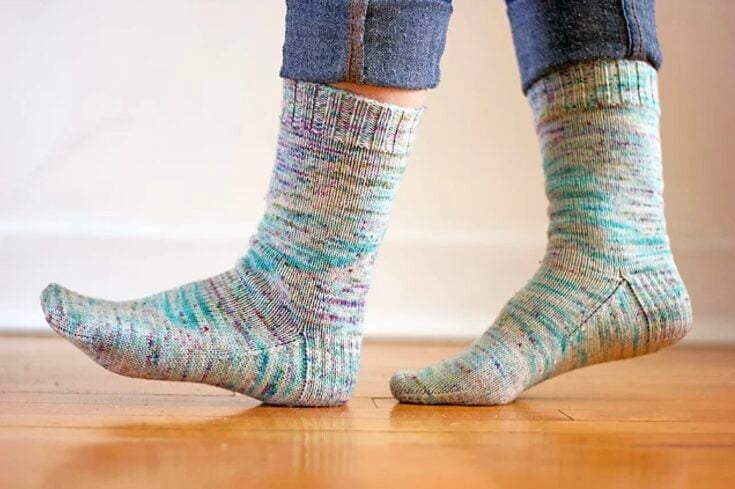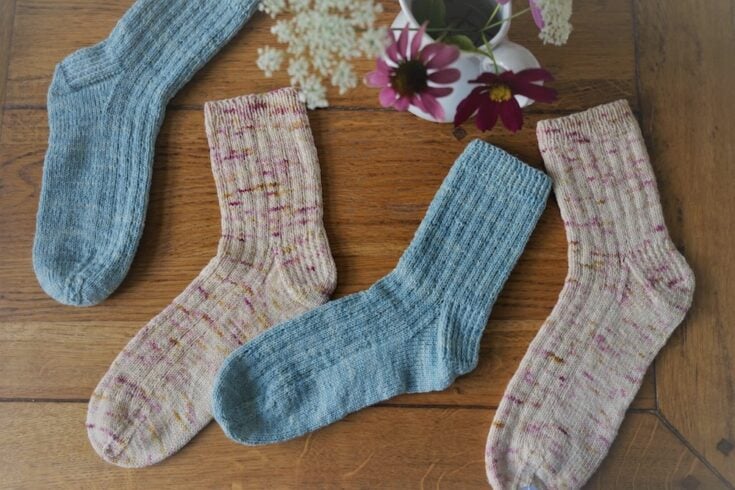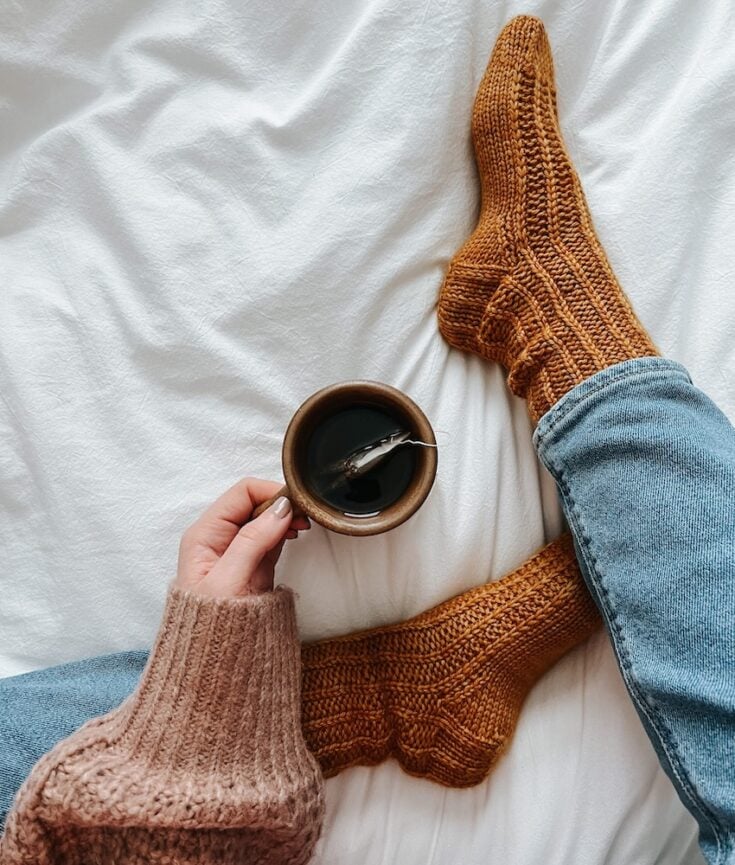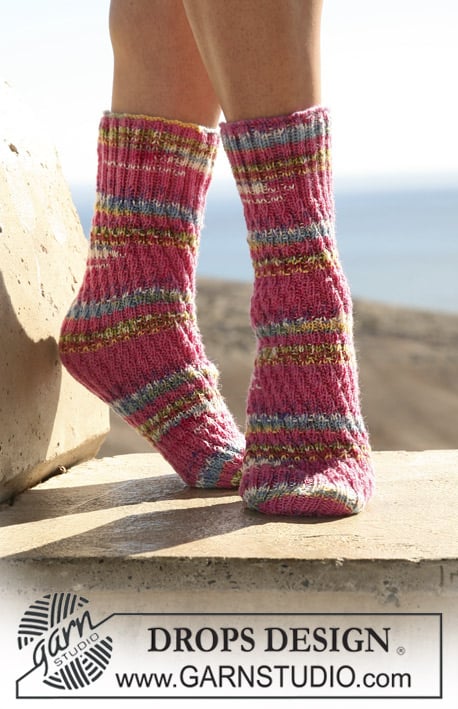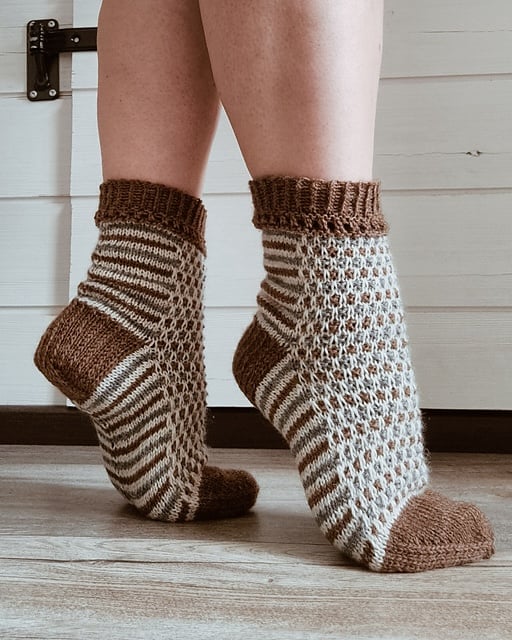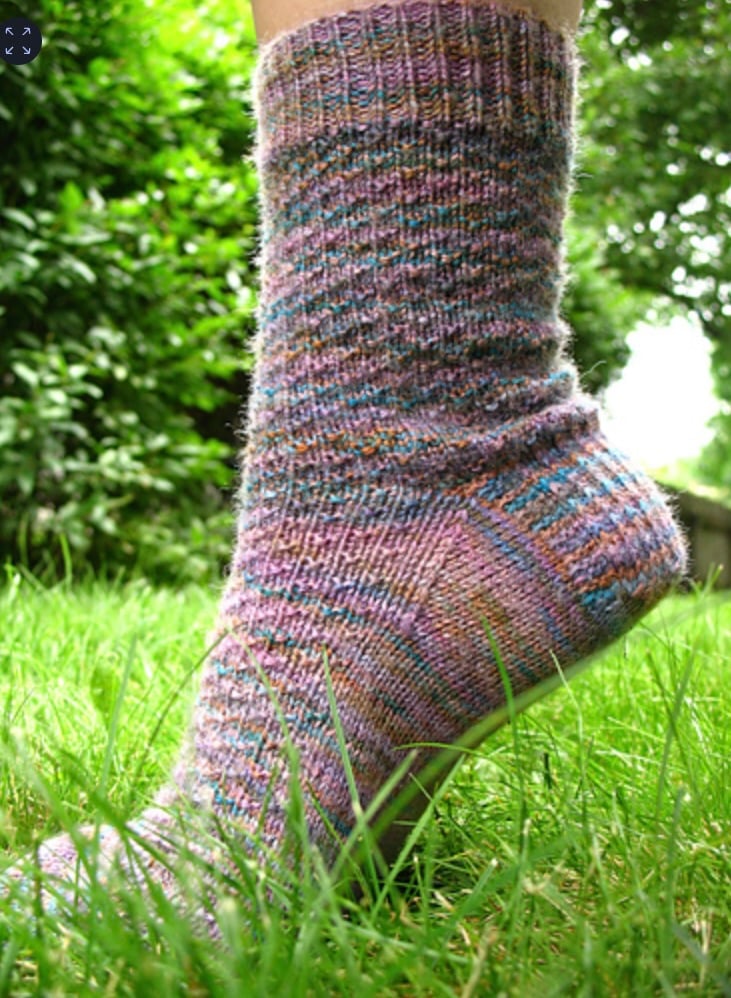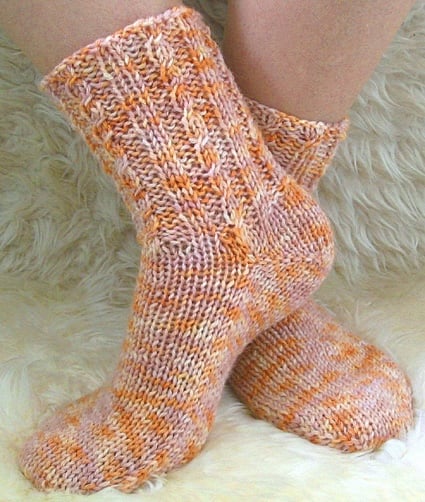29 Free Sock Knitting Patterns You Will Love!
THIS ARTICLE CONTAINS AFFILIATE LINKS THAT SUPPORT HANDY LITTLE ME CONTENT AND FREE PATTERNS.In this blog post, you will see 29 free sock knitting patterns you will love!
There are many free sock knitting patterns, and in the fall weather, who can resist sliding into a warm pair of knitted slouchy socks?
Knitting socks are not really something that I thought I would get into.
However, once I tried an easy pattern that I got free with some sock yarn, I was hooked!

Sock Knitting Patterns
Take a look at the roundup of great patterns below and feel inspired to make a pair to keep your feet warm.
Happy Knitting!
Striped Socks Knitting Pattern
This striped socks knitting pattern is a great pattern for those of you out there who love stripes!
You can make a pair of socks in all sorts of color combinations, from neutrals to pastel hues and bold brights.
A sock pattern is a great way to work on a small project during work breaks or when you are traveling.
Free Sock Knitting Pattern (Easy + Simple For Beginners)
This free sock knitting pattern is great for those of you out there who love knitting socks.
You can make a pair of socks in various color combinations, from fall colors to holiday reds and neutrals.
There are several different sizes, so you can make a pair for the whole family.
Seamed Socks Pattern by Purl Soho
Make a pair of cozy seamed socks with this free pattern.
Made out of Anzula’s Squishy, an incredibly soft hand-dyed superwash yarn with generous yardage and a touch of nylon for durability.
The knit socks will be super soft and comfy for the fall weather.
These simple socks are knit using double pointed needles in this pattern, you don’t ever actually work in the round.
Mostly you will use two double-pointed needles as if they were normal straight needles, but when you get to the Gusset heel, you will use all three needles for a short period of time.
Slouchy Socks Pattern by Yarnspirations
Make a pair of slouchy socks with this free pattern.
Bring these comfortable foot warmers to life with your creativity and Patons Shetland Chunky Tweeds yarn.
This is an intermediate pattern great for more experienced makers.
Grab the free PDF on Yarnspirations.
Easy Sock Knitting Pattern by Arne And Carlos
Make a pair of socks with this easy pattern.
With easy-to-follow instructions and a video tutorial, you will be able to make socks in no time at all!
The perfect hand-knitted socks to add to your collection.
Cozy Knit Cable Socks Pattern by Yarnspirations
Make a pair of cozy socks with a cable design.
These cozy socks are ideal for cuddling up at the cottage with a great movie or your favorite book.
Caron Simply Soft Tweeds is all about on-trend, natural looks, producing socks that essentially wear with anything.
This pattern includes a variety of sizes too, so you can whip up a few for the whole family.
Grab the free PDF on Yarnspirations.
Beginner Sock Knitting Pattern by The Snugglery
Knit a chunky and cozy pair of slipper socks with this free knitting pattern.
The beginner-friendly pattern includes helpful tips and tricks to guide you into sock knitting.
Make a pair for you or as a gift.
Basic Sock Knitting Pattern by Summer Lee
Knit a pair of soft socks to wear every day with this free knitting pattern.
The pattern is available in four sizes (S to XL).
A great project to guide you in the basics of sock knitting.
You can grab the PDF pattern for free on Ravelry.
Bunny Got Back Socks Pattern by Amy Gunderson
Knit a pair of fun socks with this free knitting pattern.
This pattern is ideal for advanced knitters who want to tackle some fancy footwork and show off their skills.
The pattern is available as a free PDF on Universal Yarn.
Vanilla Socks Pattern by Raincloud And Sage
Knit a pair of cozy socks with this free knitting tutorial.
Update 2024: The pattern is no longer available.
Lavender Lane Socks - Knitting Pattern by Mirella Moments
Knit a pair of beautiful tall socks with this free knitting pattern.
These socks are perfect for fall and winter.
The pattern includes a photo tutorial, and it's ideal for practicing these toe decreases and knitting the heel flap.
Cozy Cabin Tube Sock Knitting Pattern by Broome Fields
Knit a pair of cozy socks to keep your feet warm with this free knitting pattern.
Made in rib and stockinette stitch, these socks have a lovely stretch.
All you need is worsted weight yarn and US 8 size needles.
Marie Antoinette Socks by DROPS Design
Knit a pair of knee socks with a lace design with this free knitting pattern.
The pattern is available in sizes 35-43.
The post includes a video tutorial and helpful hints for each technique to guide you along the pattern.
Lace Socks Knitting Pattern by Yarnspriations
Knit a pair of beautiful lacy socks with a lacey design with this free knitting pattern.
The pattern is designed with experienced knitters in mind.
Grab the free PDF on Yarnspirations.
Free Sock Knitting Pattern: Simple, Dainty Texture by A Bee in The Bonnet
This pattern features a cuff-down sock with a mix of cables, lace, and textured stitches, creating a dynamic and engaging project.
The design includes a traditional heel flap and a rounded toe, offering both comfort and style.
Each section introduces new elements, making the knitting process varied and interesting.
Basic 4-ply Socks Pattern by Winwick Mum
This tutorial provides a straightforward, beginner-friendly sock pattern that guides you through the process step by step.
It includes detailed instructions with photos, making it accessible even for those new to sock knitting.
The pattern is designed to create a simple, comfortable pair of socks using basic techniques.
Ol' Reliable Top Down Socks by Tanis Lavallee
This pattern offers a classic, top-down sock design that's perfect for knitters seeking a reliable, go-to project.
The finished socks are versatile and comfortable, ideal for everyday wear.
Made in stockinette stitch, this is a great pattern for beginners as it's usually the first or second stitch a newbie learns.
The heel, however, is made using a slipped stitch pattern, which might require a little practice.
Grab the free PDF on Raverly.
Beginner Tube Sock Knitting Pattern Free by Broome Fields
This tube sock pattern is designed with simplicity in mind, making it an ideal project for beginner sock knitters.
The pattern skips the heel, offering an easy and adaptable fit for various foot sizes.
With its straightforward instructions, this project is perfect to start your sock knitting journey.
Happiness All Around Socks Knitting Pattern by Rosemary And Pine Fiber Arts
This pattern features a beautifully textured design that combines simple stitches to create a striking yet easy-to-knit sock.
It’s a versatile project suitable for knitters of all skill levels, offering both comfort and style.
The finished socks are not only cozy but also visually appealing, making them a delightful addition to any wardrobe.
Cozy Coffee Bean Socks – Free Knitting Pattern by Kneedles And Life
This pattern offers a cozy and textured sock design inspired by the comforting look of coffee beans.
It features an easy-to-follow stitch pattern that adds warmth and visual interest, making these socks perfect for chilly days.
The design is simple yet elegant, ideal for knitters looking for a quick and satisfying project.
Seas of Jupiter by DROPS Design
This sock pattern features a beautifully textured wave pattern paired with stripes, creating a visually engaging design.
These classic socks are made with fingering-weight yarn and 2.5 mm knitting needles.
Plus, there are many sizes available, so it will be easy to find your perfect fit.
Whirlwind Socks by DROPS Design
This pattern offers a simple and versatile tube sock design using DROPS Fabel yarn.
With no heel shaping, these socks are easy to knit and fit a variety of foot sizes, making them a great project for knitters of all skill levels.
The pattern's straightforward construction and the durable, comfortable yarn make these socks perfect for everyday wear.
Fjord Mosaic Set by DROPS Design
This set features beautifully knitted mittens and socks adorned with a traditional Nordic pattern, crafted using DROPS Nepal yarn.
The mittens are available in sizes S/M and M/L, while the socks accommodate foot sizes 35 to 43 (US 5 to 10½).
This set combines warmth and style, offering a cozy and visually striking addition to your winter wardrobe.
The intricate mosaic design adds a touch of Scandinavian elegance, making this set both functional and fashionable.
Orchid Socks Knitting Pattern by Mirella Moments
The knitting pattern offers a delicate and elegant design, featuring a beautiful lace motif inspired by orchid flowers.
These socks are both sophisticated and feminine, perfect for adding a touch of luxury to your sock drawer.
The pattern is detailed and accessible, making it suitable for knitters looking to create a refined, eye-catching pair of socks.
Winter Waves Socks – Free Sock Pattern by Cypress And Wool
The pattern features a cozy, textured design inspired by the gentle waves of winter seas.
This free pattern offers a simple yet elegant knit, with an easy-to-follow stitch pattern that adds both warmth and visual interest.
Perfect for cold days, these socks provide comfort and style, making them an ideal project for knitters looking to create something both practical and beautiful.
Easy Breezy Socks by Nouvelle Knitwear
This pattern features a simple, clean design that focuses on comfort and ease, making it a great go-to project for creating cozy, everyday socks.
The pattern is versatile and well-suited for those looking to knit a pair of comfortable, no-fuss socks with minimal effort.
The perfect project if this is your first pair of socks.
Grab the free PDF on Raverly.
Kick Off Socks 1.2 by Cat Krause
This pattern is a vibrant and sporty design perfect for showing team spirit or adding a pop of color to your sock drawer.
These socks are designed with a simple, clean structure, making them both comfortable and stylish.
Ideal for knitters looking to create fun, eye-catching socks, this pattern is versatile and easy to follow, suitable for all skill levels.
Grab the free PDF on Raverly.
Ilse by NinniJ. Design
These socks are designed with a top-down construction and intricate detailing, making them a rewarding project for knitters who enjoy working with lace patterns.
The finished socks are both beautiful and comfortable, perfect for adding a refined, feminine touch to your wardrobe.
Grab the free PDF on Raverly.
Hermione's Everyday Socks by Erica Lueder
Make a pair of cozy socks with this free pattern.
You can adjust your socks to your desired length.
Grab the free PDF on Raverly.
Sox On 2 Stix by Elizabeth Allen
In this blog post, you will learn how to knit a pair of socks using two needles.
All you need is DK yarn and straight knitting needles.
You can see the free knitting pattern on Knitty.
Sock Patterns Perfect For Knitting On The Go!
There’s something meditative about creating socks, knitting those rounds, and switching your brain off from everything else.
Socks are a great project to take while traveling in the car or on the train, as they need little space and pass the time quite nicely.
Recently I was traveling to Glasgow with my husband to visit some Greek relatives that have relocated and while we watched a movie, I happily sat knitting baby socks on my 4 mm (US 6) circulars.
Related Post: Baby Socks Knitting Pattern (Stripes)

Knitting Socks On Circular Needles
Socks can be knit in the round on circular needles or DPNs (double pointed needles) or knit flat (back and forth) on straight needles and later seamed.
Learning how to knit socks is a great way to develop your knitting skills and learn how to shape through increases and decreases.
This can also be a fantastic project for the fall, as you can make knit boot socks or cable knit socks for yourself and all of the family.
Related post: 13 Best Knitting Needles For Sock Knitting

Includes A Beginner Sock Knitting Pattern
This collection of sock patterns includes projects for all skill levels.
This ranges from beginner-level with video tutorials step-by-step to more intermediate patterns.
If you are looking for an easy sock-knitting pattern, you will find more than a few patterns to choose from!

More Knitting Patterns For Fall
If you are new to knitting and want to learn how to knit there are many easy and free patterns on my website, just take a look at my knitting pattern library, with patterns for women, men, babies, kids, pets, and the home.
If you are a more experienced knitter – there are so many amazing fall knitting patterns to make that will be much needed for a cozy fall – Fall Knitting Patterns {Cozy + Free!}
There are also dog sweater knitting patterns that are perfect for fall and winter – 17 Beautiful Fall Dog Sweater Knitting Patterns

Everything You Need To Know About Sock Knitting!
What are the easiest socks to knit?
The easiest socks to knit are typically simple, cuff-down socks with a basic stockinette stitch pattern. These socks start at the cuff, work down to the heel, and then continue to the toe, making the construction straightforward.
Beginners often use worsted-weight yarn and larger needles to make the process quicker and more manageable.
The heel can be worked using a short-row heel or a traditional heel flap, both of which are beginner-friendly techniques.
A simple Kitchener stitch is used to close the toe and finish the sock.
This basic design allows knitters to focus on mastering the fundamentals of sock construction without getting overwhelmed by intricate patterns.

How many styles of socks are there?
There are numerous styles of socks, each designed for different purposes and preferences.
Common styles include ankle socks, which sit just above the ankle and are great for low-cut shoes; crew socks, which are mid-length and typically reach the calf, offering a versatile everyday option; and knee-high socks, which extend up to the knee, providing extra warmth and coverage.
No-show socks are designed to be hidden inside shoes, while thigh-high socks extend above the knee for added warmth and style.
Toe socks have individual compartments for each toe, promoting natural toe movement, and slipper socks are thicker and often have non-slip soles for indoor wear.
Each style serves different needs, from fashion and warmth to specific activities or footwear types.
What is the best yarn for knitting socks?
You can knit socks in any yarn weight; it depends on your personal preference, but to be able to wear them with shoes without needing to size up, you will need a lighter yarn ( worsted, dk weight yarn, fine yarn).
The best yarn for knitting socks is generally a fingering weight yarn, which offers the perfect thickness for creating comfortable, well-fitting socks without being too bulky.
For fibers, a blend of wool and nylon is ideal.
Wool, especially superwash wool, is favored for its natural elasticity, warmth, and moisture-wicking properties, making it both comfortable and practical for socks.
Nylon adds essential durability and strength, helping the socks resist wear and prolong their lifespan.
A common and highly recommended blend is 75-80% wool and 20-25% nylon, providing the right mix of softness, warmth, and resilience needed for high-quality, long-lasting socks.
- Learn everything about the different yarn weights here – Yarn Weight Guide {+ Conversion Chart}
- Learn everything about yarn fibers here – Yarn Types Explained: A Guide To Different Fibers
- Learn how to read a yarn label here – How To Read A Yarn Label (Step By Step)

What are the best knitting needles for sock knitting?
The best knitting needles for sock knitting are typically small, fine needles that match the gauge required for sock yarn.
Double-pointed needles (DPNs) and circular needles are the most popular choices.
- Double-Pointed Needles (DPNs): These are traditional and commonly used for sock knitting. They usually come in sizes ranging from US 0 to US 2 (2.0 mm to 2.75 mm) for fingering weight yarn. DPNs allow you to knit in the round on a small circumference, making them ideal for socks.
- Circular Needles: Many knitters prefer the magic loop method or using two circular needles, especially when knitting two socks at once. For magic loop, a 32 to 40-inch (80 to 100 cm) circular needle with a flexible cable works best. This method reduces the risk of ladders (gaps between needle changes) and can be more convenient for travel knitting.
Related Post: 13 Best Knitting Needles For Sock Knitting

Are there many types of knit socks?
There are different ways to knit socks, each offering a different approach to construction and fit:
- Cuff-Down Socks: This is the most traditional method, where you start knitting at the cuff and work your way down to the toe. It often involves a heel flap and gusset or a short-row heel.
- Toe-Up Socks: In this method, you begin at the toe and work your way up to the cuff. Toe-up socks are popular for allowing you to try on the sock as you go, ensuring a good fit, and they’re great for using up all your yarn without worrying about running out.
- Tube Socks: These socks are knit without a heel, making them very simple and adaptable to different foot sizes. The stretchiness of the pattern allows the sock to fit snugly around the foot.
- Afterthought Heel Socks: These are knit in a tube, and the heel is added later by picking up stitches and creating the heel after the rest of the sock is complete. This method allows for easy replacement of worn heels.
- Two-at-a-Time Socks: This method allows you to knit both socks simultaneously on one long circular needle using the magic loop method. It ensures both socks are identical and eliminates second-sock syndrome.
- Magic Loop Socks: A technique where you use a long circular needle to knit socks in the round. It’s versatile and can be used for both cuff-down and toe-up socks.
Each method offers different benefits, so knitters can choose the technique that best suits their preferences and the type of sock they want to create.
Related Post: Magic Loop Knitting | Step By Step

Essential supplies for knitting socks
In addition to yarn, needles, and a pattern, there are a few essential supplies you’ll need to knit socks.
- A good set of stitch markers is crucial for keeping track of the beginning of rounds, pattern repeats, and any increases or decreases.
- A tapestry needle (or darning needle) is necessary for weaving in the yarn ends and for grafting the toe using the Kitchener stitch.
- You might also want a row counter to help keep track of your progress, especially if the pattern is intricate.
- A small pair of sharp scissors will be handy for cutting yarn, and a sock blocker can be useful for shaping and finishing your socks to give them a professional look.
- Some knitters also use a measuring tape to ensure accurate sizing, particularly when checking foot length or gauge.
Having these supplies on hand will make the sock knitting process smoother and more enjoyable.
Related Post: Knitting Tools For Beginners + Essential Accessories
How many hours does it take to knit a pair of socks?
The time it takes to knit a pair of socks can vary widely depending on several factors, including the knitter’s skill level, the complexity of the pattern, the yarn weight, and the size of the socks.
On average, for a relatively simple pair of socks using fingering weight yarn, an experienced knitter might take around 10-20 hours to complete a pair.
Beginners or those working with more intricate patterns might take longer, potentially 20-30 hours or more.
Using thicker yarn, such as worsted weight, can reduce the time needed, as fewer stitches are required.
How do you measure for a hand-knitted sock?
To ensure a good fit for a hand-knitted sock, it’s important to take accurate measurements of your foot.
Start by measuring the circumference of the widest part of your foot, typically around the ball, as this will help determine the sock’s width.
Next, measure the length of your foot from the tip of your longest toe to the back of your heel.
Finally, measure the circumference around your ankle and the narrowest part of your leg where the sock will sit.
These measurements will guide you in adjusting the pattern to match your foot size, ensuring the sock has the right amount of negative ease for a snug, comfortable fit.
Knitting Lessons
If you are new to the craft and need help with the knitting basics, check out more free how-to resources here: Knitting Lessons (With Video Tutorials).
There, you will find step-by-step tutorials for all the different knitting techniques a newbie needs to know.
This includes how to cast on, how to bind off, how to knit the basic stitches, how to knit the knit stitch, how to knit the purl stitches, and how to knit the rib stitch pattern.
How to make the mattress stitch, short rows, yarn over(yo), knit the slip stitch, how to tink, use the magic loop technique, how to decrease knitting, how to change yarn colors, and more.
Also included is a list of knitting abbreviations (UK + US terms), a knitting needle size guide, and more.
And if you need more video tutorials to help you practice your basic knitting skills, check out my YouTube channel here – Handy Little Me – YouTube.
For extra help and to connect with more makers, check out the Handylittleme Facebook group.
If you also love to crochet, check out easy patterns here – Free Crochet Patterns
You can also find us on social media, Pinterest, Instagram, Twitter, Etsy, and TikTok.
More Patterns You May Be Interested In…
- How To Knit A Hat For Complete Beginners (+ Video Tutorial)
- 20 Temperature Blanket Patterns (The Ultimate Guide)
- How To Knit A Hat With Circular Needles (Step-By-Step)
- 31 Free Baby Blanket Knitting Patterns (Easy Knit Blankets)
- How To Knit Baby Booties (Step-By-Step)
- Knitted Dog Sweater Pattern (3 Sizes)
- 12 Simple Knitting Stitches For Beginners
- Free Knitted Dishcloth Patterns
- 37+ Patterns To Use Up Your Yarn Stash (Small Projects)
- Free Dog Sweater Knitting Pattern (Straight Needles)
- Super Easy Corner To Corner Baby Blanket Pattern (Knit)
- Easy Baby Sweater Knitting Pattern For Beginners
- 3O Free Easy Fall Knitting Projects For Beginners
- Pumpkin Knitting Pattern (Beginner Friendly!)
- 30 Free Legwarmer Knitting Patterns (Super Cozy)
- Free Knitted Heart Pattern (Easy + Quick Project)
- 20+ Fall Oversized Knits (Sweater Knitting Patterns)
- Ribbed Beanie Knitting Pattern (Unisex Mariner’s Hat)
- Garter Stitch Scarf Pattern – Simple For Beginners
- How To Knit A Gauge Swatch (Measure Knitting)
- What Is TBL In Knitting? (Knit Through The Back Loop)
- One Skein Knit Hat Pattern (Easy Quick Simple Cable)
- Knitting Slippers – 27 Cozy Slippers To Knit (Free Patterns)












